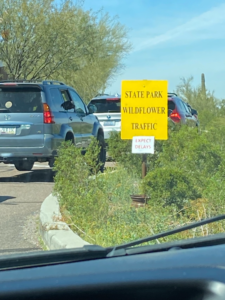In the last few weeks of February and early March, Picacho Peak State Park is a riot of color. Mexican gold poppies and purple lupine carpet the ground beneath the stunning rocky prominence.
Less than a two-hour drive from the N2 Explore office, I joined the long line at the front gate of the park. I immediately realized that 11 am was not early enough to arrive during prime wildflower season. My friend, Jen, who was joining me, arrived 10 minutes later, putting her a half hour behind me in line. Luckily, I could at least see the peak and the flowers from the road, so I turned on some tunes and got comfy in the driver’s seat for the wait.
When we were finally able to park, we donned our hiking boots and sunscreen for a “quick” day hike up Picacho Peak and some leisurely flower-bathing (like forest-bathing, but more colorful). Whether you’re an experienced hiker or a newbie, the 2-mile trail to the summit of Picacho Peak may sound like no big deal, until you’re standing at the trailhead looking at the mountain. It appears to be sheer rock stabbing up from the ground. I wondered to myself, “how on earth is there a trail to the top of that? Looks more like rock-climbing to me.”
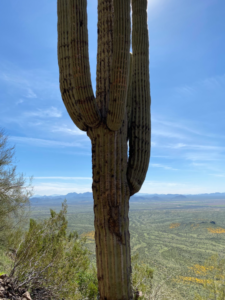 With a bit of blind faith, we set off up the trail. The bottom section of the hike wound its way up the desert hillside. Arizona has gotten some record rainfalls through the end of 2022 and beginning of 2023, so the desert was lusher than I had ever seen it. The saguaros and hedgehog cactuses were plump and happy, and I gave them a wide berth.
With a bit of blind faith, we set off up the trail. The bottom section of the hike wound its way up the desert hillside. Arizona has gotten some record rainfalls through the end of 2022 and beginning of 2023, so the desert was lusher than I had ever seen it. The saguaros and hedgehog cactuses were plump and happy, and I gave them a wide berth. 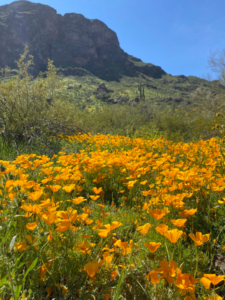 Large swaths of earth were coated in golden poppies, smiling up at the sun. Each new cluster of flowers begged for us to stop and admire them, slowing our progress considerably, but greatly increasing my joy.
Large swaths of earth were coated in golden poppies, smiling up at the sun. Each new cluster of flowers begged for us to stop and admire them, slowing our progress considerably, but greatly increasing my joy.
Jen was leading the way when the sudden rattling of a tiger rattlesnake (later identified) nearly scared her off the trail. We each leapt away from the creature who had found a comfy place in the bushes only a few feet from the well-traveled path. After a few moments of heart-racing terror and our due diligence of warning the next hikers on the trail, we continued on our way.
As we approached the base of the rocky prominence, I searched the face for any sign of a path or humans moving upward but saw nothing. At last, we reached a small overhanging cave at the base of the mountain, and I laid my hands upon its rough surface. The trail hugged the rock and headed to the right up to a small shoulder. There we found that the path to the top was in fact on the back of the mountain. Not only that, but we would steeply lose ground before heading upward again.
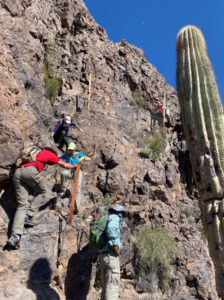 This is where the fun begins. Handrails and chains protrude from slick rock slabs, leading down the backside of the mountain. With a firm grip, I carefully lowered my body down the slabs, never fully trusting my weight to my feet. Jen and I laughed as we awkwardly moved over the rocks, noting the different flowers that populated the south side of the mountain. We checked the GPS track for the trail trying to determine just how much farther there was to the top, and how much of it might be this perilous style of route with only chains to hold onto.
This is where the fun begins. Handrails and chains protrude from slick rock slabs, leading down the backside of the mountain. With a firm grip, I carefully lowered my body down the slabs, never fully trusting my weight to my feet. Jen and I laughed as we awkwardly moved over the rocks, noting the different flowers that populated the south side of the mountain. We checked the GPS track for the trail trying to determine just how much farther there was to the top, and how much of it might be this perilous style of route with only chains to hold onto.
We went down much longer than I would have liked, and then turned steeply back up again. As we climbed, we stopped frequently. The afternoon heat was zapping our strength, even with adequate hydration and snacks. Pulling ourselves up the short sections of chains hand over hand was an arduous process and I knew then that my muscles would be sore in the morning.
At the bottom of the last push to the peak, we stopped to rest on a flat outcropping. A long section of chains, steep stairs and even a stretch of mesh fencing conspired to keep hikers from toppling from the very last obstacle before the peak. Additionally, these tools condensed the route to a treacherous and scary one-way traffic situation. Groups of hikers took turns going up and down, each person picking their way carefully over the slickest sections of rock, which have seen the smoothing effects of many thousands of pairs of feet since the park’s inception in the late 60s.
In a game time decision, we decided to head back down and avoid waiting in a long line to complete the hike, followed by another long line to leave the summit. The views from our little perch beneath the summit were quite spectacular in themselves, and all the more time for the wildflowers on the way back down.
That night, we cooked our favorite camp foods on the picnic table and watched as the sky erupted in deep shades of pink and purple. We were grateful to be staying the night in the park, so that we could wake early and see the flowers in the pre-dawn, pre-day-entry glow.
Best Time to Visit
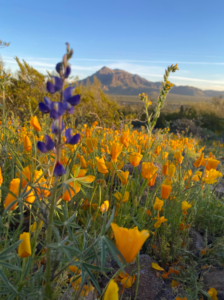 If you’re hoping to catch the wildflower bloom, February and March are prime times to visit Picacho Peak. The State Parks and Trail Organization even keeps a wildflower tracker on their website, to let us know when flowers start blooming and what the current state of the flowers in the park are.
If you’re hoping to catch the wildflower bloom, February and March are prime times to visit Picacho Peak. The State Parks and Trail Organization even keeps a wildflower tracker on their website, to let us know when flowers start blooming and what the current state of the flowers in the park are.
The hiking trails are quite exposed, and temperatures often exceed 100° F in the summer, so if you’re hoping to summit Picacho Peak, October through April are ideal—but keep an eye out for recent rain/snow fall, as the rockier sections of trail will be quite dangerous when wet.
If you’re interested in wildlife, Picacho Peak State Park is home to dozens of mammals, reptiles, birds, and invertebrates. Any time of year, there is some wildlife to see, but some seasons are extra special. During monsoon season, you may even catch a rare amphibian sighting, the Sonoran Desert toad.
How to Camp
Within the state park, there are 85 tent and RV campsites. In a ring right at the foot of the mountain, this is the easiest access to the park and the only access during the gates closed hours of 10pm-5am. If you want to experience the park at sunrise, staying at the campground may be your best bet. These campsites fill up quickly, especially for the peak wildflower season, and should be reserved ahead of time. For more information, check out the Picacho Peak State Park website.
Go there with N2 Explore! Book a rental at Go-Camp or Outdoorsy.
Guest writer: Christine Reed, @ruggedoutdoorswoman.

